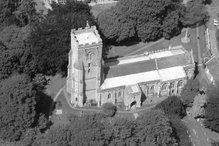St Peter & All Hallows, West Huntspill, Somerset. (Church of England) A Christian community existed here at Huntspill from before AD 787 when, during the reign of the Saxon King Offa, the manor and land at Huntspill being given to Glastonbury Abbey. After the Norman Conquest, the manor was taken from Glastonbury and came into the possession of a Norman Lord, Walter de Douai. In AD 1208 the “church and all its appurtenances” was donated by the Lord of the manor, Fulke Paganel, to a Priory which he founded at Newport Pagnell in Buckinghamshire. We do not know what this church was or exactly where it was situated, but 100 years later, the church came under the control of the Bishop of Wells and Rectors from that date, ie the late 1200's, are known and listed on the northeast wall of the Nave and the parish church is now under the continuing patronage of Balliol College, Oxford.
The earliest part of the church to be seen now is the Nave with its late 13th century windows, large Ham stone pillars and string courses. Effigies in the niche on the South wall probably date from the 14th century and represent the Lord of the Manor, Sir Richard Cogan and his wife Isobella. During the 15th century, after the ‘Black Death’, the church was enlarged. The Chancel was extended towards the east, the side chapels were built with large perpendicular windows and the tower added or rebuilt.
Sometime later the north sanctuary window was blocked off and the priest’s vestry added to the northeast corner of the church. Small windows in its east wall show that it once had two floors. A door in the north wall of the nave near to the organ leads up to the roof and to a blocked doorway that once gave access to a Rood Loft. By the mid 19th century the interior of the church contained a gallery and ringing balcony under the tower and heavy wooden pews facing the pulpit; but all this was removed in an extensive renovation of the interior in the Spring of 1878. In the December of that same year a great fire destroyed the roof and interior furnishings, leaving only the walls standing and the Ham stone pillars reddened by the heat of the fire as we see them today.
The church was rebuilt and restored as nearly as possible to its original condition and reopened by 1880. The stone corbels, half-length angel figures, each carrying a shield with one of the instruments of the Passion carved on it were replaced in the Chancel also the stone heads in the Nave. All other stone statues and religious effigies were destroyed during the Reformation. One ‘angel’ found damaged in the churchyard, now sits upon the stone seat in the south porch.
The Lady Chapel was restored in 1947 and dedicated as a War Memorial Chapel and rededicated to Our Lady and St Nicholas, as the chapel of St Nicholas was the northeast chapel and now hosts the organ and access to the priest’s vestry. The area under the tower and the rear of the Nave was reordered in the mid 1980’s bringing the font from under the tower to the rear of the nave, creating a Children’s Corner. The front of the Nave was reordered in the late 1990’s to allow for a flexibility in worship. ............................................................... For further information please contact the Rector. The Reverend Geoffrey Walsh 01278 793950 walsh007@talktalk.net |
